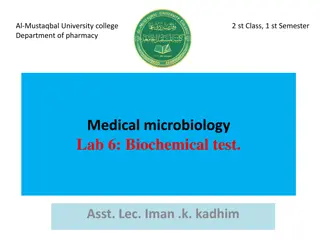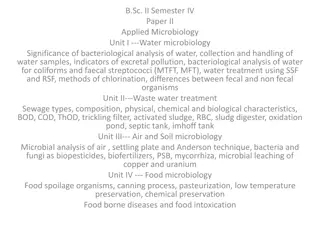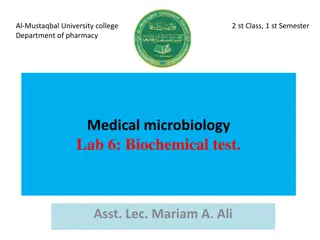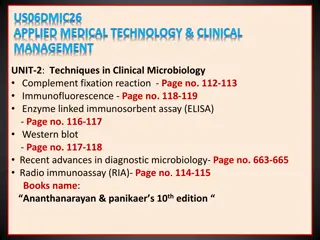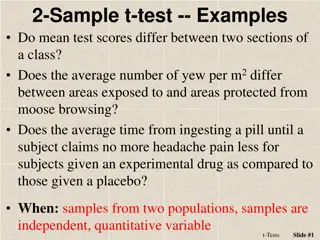Understanding Coagulase Test in Microbiology
The Coagulase test is a crucial microbiological method used to differentiate Staphylococcus aureus (Coagulase Positive) from other Staphylococci (Coagulase Negative). By detecting the presence of the enzyme coagulase, this test helps identify pathogenic strains of Staphylococcus that can cause serious infections. The test involves detecting bound and free coagulase using specific procedures like Slide Test and Tube Test, aiding in accurate microbial identification. Catalase test is also discussed as a complementary method to differentiate catalase-producing bacteria like staphylococci from others.
Download Presentation

Please find below an Image/Link to download the presentation.
The content on the website is provided AS IS for your information and personal use only. It may not be sold, licensed, or shared on other websites without obtaining consent from the author. Download presentation by click this link. If you encounter any issues during the download, it is possible that the publisher has removed the file from their server.
E N D
Presentation Transcript
Coagulase test Catalase test Oxidase test
Coagulase aureus (positive) which produce the enzyme coagulase, from S. epidermis and S. saprophyticus (negative) which do not produce coagulase. i.eCoagulase Negative Staphylococcus (CONS). test is used to differentiate Staphylococcus Coagulase is an enzyme-like protein and causes plasma to clot by converting fibrinogen to fibrin. Staphylococcus aureus produces two forms of coagulase: bound and free. Bound coagulase (clumping factor) is bound to the bacterial cell wall and reacts directly with fibrinogen. This results in an alternation of fibrinogen so that it precipitates on the staphylococcal cell, causing the cells to clump when a bacterial suspension is mixed with plasma. This doesn t require coagulase-reacting factor.
Free plasma coagulase-reacting factor (CRF), which is a modified or derived thrombin molecule, to from a coagulase-CRF complex. This complex in turn reacts with fibrinogen to produce the fibrin clot. coagulase involves the activation of
SlideTest (to detect bound coagulase) Place a drop of physiological saline on each end of a slide,orontwo separate slides. With the loop, straight wire or wodden stick, emulsify a portion of the isolated colony in each drops to make two thicksuspensions. Add a drop of human or rabbit plasma to one of the suspensions,and mixgently. Look for clumping of the organisms within 10 seconds. No plasma is added to the second suspension to differentiateany granular appearance of the organism fromtruecoagulase clumping.
TubeTest (to detect free coagulase) The tube test uses rabbit plasma that has been inoculated with a staphylococcal colony ( Gram- positive cocci ). The tube is then incubated at 37 C for 1.5 hours. If negative, then incubation is continued upto 18 hours. If 'positive' (e.g., the suspect colony is S. aureus), the plasma will coagulate, resulting in a clot (sometimes the clot is so pronounced, the liquid will completely solidify).
This test demonstrate the presence of catalase, an enzyme that catalyses the release of oxygen from hydrogen peroxide (H2O2). Catalase test is used to differentiate those bacteria that produces an enzyme catalase, such as staphylococci, from non-catalase producingbacteriasuchasstreptococci.
The enzyme catalase mediates the breakdown of hydrogen peroxide into oxygen and water. The presence of the enzyme in a bacterial isolate is evident when a small inoculum is introduced into hydrogen peroxide, elaboration of oxygen bubbles occurs. The lack of catalase is evident by a lack of or weak bubble production. The culture should not be more than 24hoursold. 2H2O2 2H2O + O2(gas bubbles) catalase and the rapid
Bacteria thereby protect themselves from the lethal effect of Hydrogen peroxide which is accumulated as an end product of aerobic carbohydrate metabolism. Catalase-positive bacteria include strict aerobes as well as facultative anaerobes. They all have the ability to respire using oxygen as a terminal electron acceptor.
Catalase-negative anaerobes, or they may be facultative anaerobes that only ferment and do not respire using oxygen as a terminal electron acceptor (ie. Streptococci). bacteria may be
The catalase test is primarily used to distinguish among Gram-positive cocci: members of the genus Staphylococcus are catalase-positive, and members of the genera Streptococcus and Enterococcus are catalase-negative. Catalase test is used to differentiate aerotolerant strains of Clostridium, which are catalase negative, from Bacillus species, which are positive.
Catalase test can be used as an aid to the identification of Members of Enterobacteriaceae family are catalase positive e.g., (E. coli, Citrobacter, Enterobacter, Klebsiella, Shigella, Yersinia, Proteus, Salmonella, Serratia). Enterobacteriaceae.
Transfer a small amount of bacterial colony to a surface of clean, dry glass slide using a loop or sterile wooden stick Place a drop of 3% H2O2 on to the slide and mix. A positive result is the rapid evolution of oxygen (within 5-10 sec.) as evidenced by bubbling. A negative result is no bubbles or only a few scattered bubbles.
Add 4 to 5 drops of 3% H2O2 (Hydrogen peroxide) to in a test tube Using a wooden applicator stick, collect a small amount of organism from a well-isolated 18- to 24-hour colony and place into the test tube. Place the tube against a dark background and observe for immediate bubble formation (O2 + water = bubbles) at the end of the wooden applicator stick.
Catalase Positive reactions: Evident by immediate effervescence (bubble formation) Catalase Negative reaction: No bubble formation (no catalase enzyme to hydrolyze the hydrogen peroxide).
The oxidase test detects the presence of a cytochrome oxidase system that will catalyse the transport of electrons between electron donors in the bacteria and a redox dye- tetramethyl-p-phenylene-diamine. The dye is reduced to deep purple color. This test is used to assist in the identification of Pseudomonas, Neisseria, Aeromonas, Campylobacter, Vibrio, Brucella and Pasteurella, all of which produce the enzyme cytochrome oxidase.
A number of reagents can be used for this test. Kovacs Oxidase Reagent: 1% tetra-methyl-p-phenylenediamine dihydrochloride, in water Gordon and McLeod s Reagent: 1% dimethyl-p-phenylenediamine dihydrochloride, in water Gaby and Hadley (indophenol oxidase) Reagent: 1% -naphthol in 95% ethanol 1% p-aminodimethylaniline HCL
The Cytochrome containing organisms produce an intracellular oxidase enzyme. This oxidase enzyme catalyzes the oxidation of cytochrome c. Organisms which contain cytochrome c as part of their respiratory chain are oxidase- positive and turn the reagent blue/purple. Organisms lacking cytochrome c as part of their respiratory chain do not oxidize the reagent, leaving it colorless within the limits of the test, and are oxidase-negative.
The cytochrome system is usually only present in aerobic organisms which are capable of utilizing oxygen as the final hydrogen receptor. The end product of this metabolism is either water or hydrogen peroxide (broken down by catalase).




